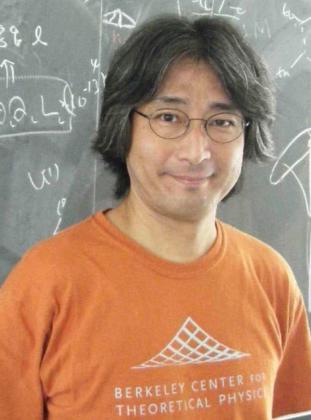Hitoshi Murayama

Specialty areas
Collider Physics, Neutrino Physics, Particle Cosmology, Supersymmetry Phenomenology and Field Theories.
Biography
I am a theoretical physicist working on a wide range of topics: particle physics beyond the standard model, quantum field theory, collider physics, dark matter, dark energy, inflation, grand unification, neutrino physics. More recently I work on condensed matter physics and lead a collaboration on astronomy called SuMIRe (video). I worked on KamLANDneutrino experiment (see the evidence). For further information, see the list of publications. My CV is here in PDF.
Mentoring
My students have done very well. Nima Arkani-Hamed (Faculty, IAS) was the first student I worked with, even though he was officially a student of Lawrence Hall. I officialy supervised André de Gouvêa (Faculty, Northwestern), Alexander Friedland (Senior Staff, SLAC National Laboratory), Aaron Pierce (Faculty, Michigan), Daniel Larson (Lecturer, Harvard), Roni Harnik (Senior Staff, Fermilab), Matt Buckley (Faculty, Rutgers), Sourav Mandal (Institute for Defense Analyses), Vikram Rentala (faculty, ITT Bombay), Willie Klemm (postdoc, Uppsala), Brian Henning (postdoc, Yale), Xiaochuan Lu (postdoc, UC Davis).
Courses
Physics 7C (Spring 1996)
229A (Fall 1996)
229B (Spring 1997)
129A (Fall 1997)
129B (Spring 1998)
229C (Fall 1998)
229A (Fall 1999)
229B (Spring 2000)
221B (Spring 2001)
221A (Fall 2001)
221B (Spring 2002)
129A (Fall 2002)
221A (Fall 2004)
221B (Spring 2005)
229C (Fall 2005)
221A (Fall 2006)
230A (Spring 2007)
233B (Fall 2007)
232A (Fall 2009) 232B (Spring 2010)
232B (Spring 2011)
232B (Spring 2012)
233B (Fall 2012)
232B (Spring 2013)
232B (Spring 2014)
Research
Popular Talks (Video)
- Quantum Universe
- Hintze Lecture at Oxford 2015
- Where do we come from? Science is making progress on this age-old question of humankind. The Universe was once much smaller than the size of an atom. Small things mattered in the small Universe, where quantum physics dominated the scene. To understand the way the Universe is today, we have to solve remaining major puzzles. The Higgs boson that was discovered recently is holding our body together from evaporating in a nanosecond. But we still do not know what exactly it is. The mysterious dark matter is holding the galaxy together, and we would not have been born without it. But nobody has seen it directly. And what is the very beginning of the Universe?
- Dark Matters
- Talk at TEDxTokyo 2010
- Promotion video for Coursera MOOC
- Nearly 50,000 students signed up for this online course from more than 140 countries
- E=mc2
- A talk at Lawrence Berkeley National Laboratory on Einstein’s famous equation
- Mysteries of the Quantum Universe
- A public talk at an IMAX theater at Science World in Vancouver
- Recent Talks for Physicists
- When a Symmetry Breaks (video)
- What is common among a magnet, a flounder, a rack of laundry, your heart on the left of your body, and the Higgs boson? The concept of spontaneous symmetry breaking is ubiquitous among many natural phenomena. Iâll describe the basic concept and its applications. In particular, the original concepts from Anderson, Nambu, Goldstone, and Higgs do not quite work in many systems that include a magnet on your fridge. I generalize the concept so that it is applicable to all known natural phenomena around us.
- Colloquium at Cornell on Oct. 19, 2015
- What’s wrong with Goldstone? (PDF)
- Spontaneous Symmetry Breaking is a very universal concept applicable for a wide range of subjects: crystal, superfluid, neutron stars, Higgs boson, magnets, and many others. Yet there is a variety in the spectrum of gapless excitations even when the symmetry breaking patterns are the same. We unified all known examples in a single-line Lagrangian of the low-energy effective theory. In addition, we now have a better understanding of what happens with spacetime symmetries, and predict gaps for certain states exactly based on symmetries alone.
- Seminar at CERN on Dec 11, 2013
- The Dark Side of the Universe (video)
- Asian Europe Physics Summit 2011 in Wroclaw, Poland
- Closing Lecture at CERN Summer Institute 2011 (video)
- Lectures on the Standard Model at CERN Summer Institute 2009 (video)
- Lectures on the Baryon Asymmetry at CERN Academic Training Lecture 2010 (video)
